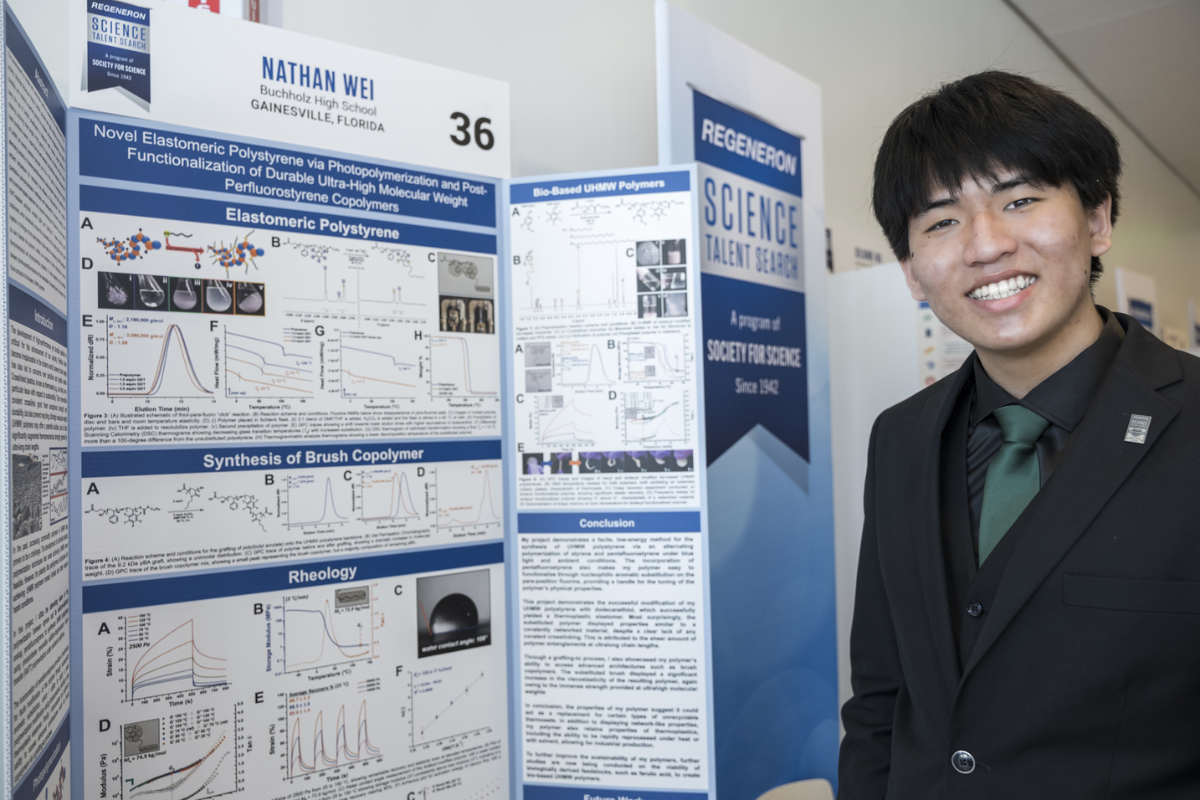
High schooler Nathan Wei’s project, “Novel Elastomeric Polystyrene via Photopolymerization and Post-Functionalization of Durable Ultra-High Molecular Weight Perfluorostyrene Copolymers,” won fourth prize in the Regeneron Science Talent Search. | Courtesy of Regeneron Science Talent Search
A high school senior from Gainesville, Florida, took fourth place in a national science competition based on his work to make it easier to break down hard-to-recycle plastics.
Nathan Wei’s project was part of the Regeneron Science Talent Search, which had over 2,100 entrants. He chose the project based on his interest in chemistry, his mentor Brent Sumerlin’s work at the University of Florida and his desire to help address plastic pollution.
“Everything in the world is plastic, basically,” Wei told Plastics Recycling Update. “Plastics are so important, but we have this huge problem with plastic sustainability and plastic pollution.”
Wei won a $100,000 prize, which he plans to use to pay for college tuition. His project, “Novel Elastomeric Polystyrene via Photopolymerization and Post-Functionalization of Durable Ultra-High Molecular Weight Perfluorostyrene Copolymers,” could help bring currently unrecyclable materials into the mechanical recycling stream. It could also be used to bring more bio-based materials into plastics.
“We can take plastics that traditionally just get stuck in landfills and hopefully be able to recycle them and reuse them,” Wei said.
Wei developed a new method to synthesize ultra-high molecular weight plastics, which is much less energy intensive than existing methods. He also modified the polymer to create a strong and rubbery material that is recyclable under heat.
“The problem I was trying to tackle has to do with thermosets, which are basically unrecyclable, and one solution that polymer chemists proposed recently has been to make these plastics with reversible reactive covalent bonds, so when you heat it up you can get it to be re-processable,” Wei said.
A covalent bond is formed when electrons are shared equally between atoms. They make a molecule more stable. Wei’s initial plan was to put reversible reactive covalent bonds in his polymer, but in the process he realized that the same effect could be achieved by enhancing the level of entanglements within the polymer.
“It was an unexpected way to achieve the exact same goal we were looking for, which was really cool,” Wei said.
That unexpected result “just shows something else about ultra-high molecular weight plastic that we haven’t known in the past, because we just don’t have a great understanding of how polymers and plastic chains work at such high chain lengths,” he added.
Looking forward, Wei said he and Sumerlin, as well as his mentor Kevin Stewart, are still working on some continuations together, testing how different biologically derived resources can be incorporated into the polymers, “so we can eliminate some fossil fuel usage in the plastic and provide them with more functionality.”
Wei isn’t sure if he will stay in plastics research, but “obviously we’re always going to need to make new plastics.”
“It’s definitely a field that’s got a lot more to explore, but really I think whatever path I take in the future will kind of depend on what happens in college,” he said. “I do hope that I stay in chemistry.”

